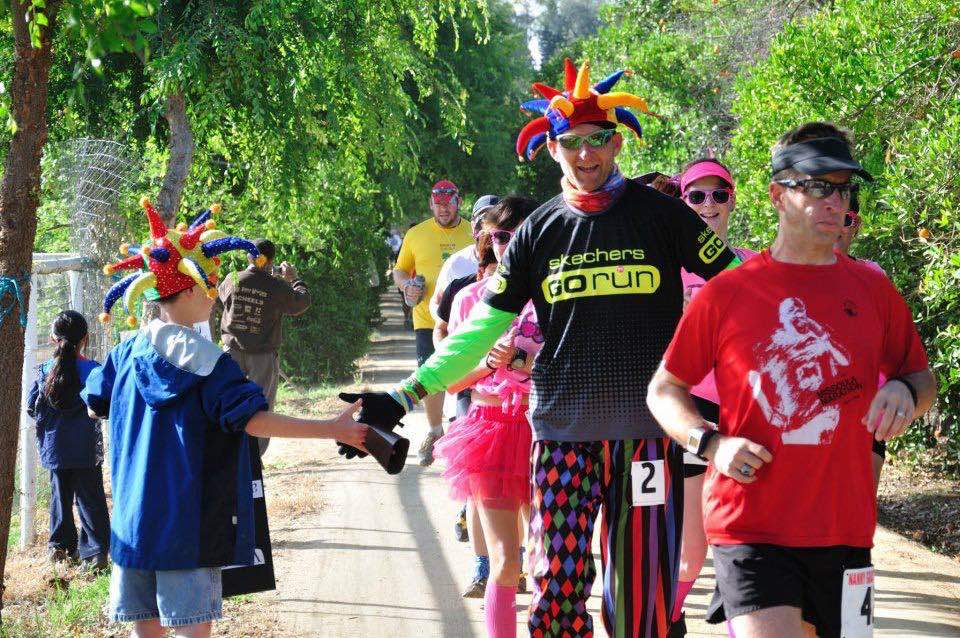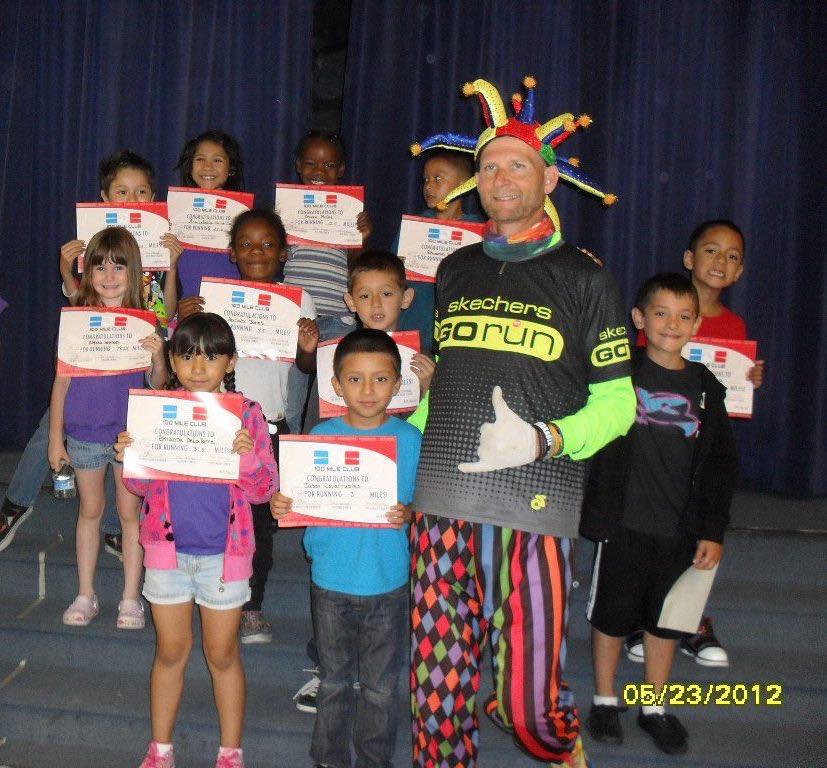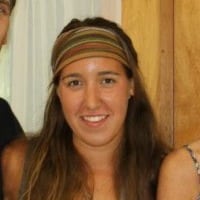On the first weekend of December in 2014, Ed ‘The Jester’ Ettinghausen had just tied and then surpassed the record of 100-mile races completed in one year. He then went on to finish four more, and if there had been a 13th month that calendar year, he would have happily continued. He was on fire in 2014.
So, when he crossed the finish line of his 41st 100 miler on December 28, 2014, Ed was beyond thrilled to accomplish his goal, and yet, he was also a little distraught that it was already over.
“It was actually a letdown when we got to the end of the year,” Ed admitted. Now, as a 55 year old, Ed says he will do it all again–another entire year of counting 100-mile finishes. “It was a relief, yes, that I made my goal, but I had been so mentally focused for a year… every weekend running a 100 miler. When it was finally over, I was at loss.”
Okay, he asked himself, what do I do now?
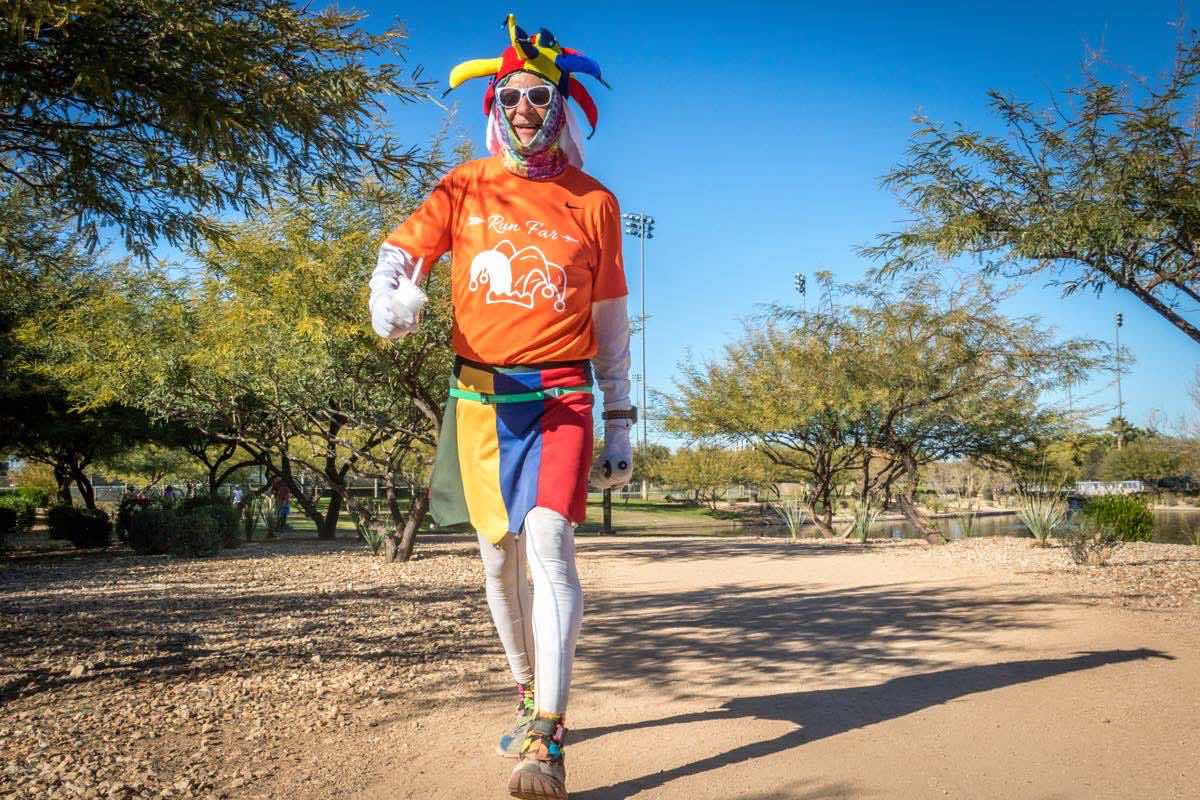
Ed Ettinghausen running the 2017 Across the Years race. Photo: Jubilee Paige
Ed Ettinghausen is known as The Jester, and he rarely shows up to race in anything but one of his wild hats, rainbow skirt, and colorful accessories. Actually, the last time he was not in Jester attire, he donned the black clothing of Darth Vader. He says that was at last year’s Los Angeles Marathon, but that’s probably another story.
When he started running, officially only nine years ago at age 46, he was not yet The Jester. The costume developed from being The Surfer Dude, a character he dressed as to perform a fun skit for the nervous new runners of California’s Riverside Road Runners Marathon Training Club. Ed was a coach and founder of the group, and was helping train runners for the Surf City Marathon. He, The Surfer Dude, donned in a loud Hawaiian shirt and board shorts, ran alongside his fellow runners throughout the race. This was the birth place of Ed’s playful running attire.
“I decided I wanted to keep having fun so I started running with colorful hats and just kept wearing them each time,” he said. The colorful headwear broke up the monotony of so many marathon miles.
“I went to Goodwill and bought a lot of funny hats,” he added. “At one point, I put on the jester hat and it just seemed to fit my personality and I just kept wearing it.”
With his wife Martha’s help, he traded the board shorts for a colorful skirt and it has been his go-to outfit at 99 percent of his races since 2011. When asked how many jester hats he owns, he guessed 20.

Ed exchanging high-fives with other runners at the 2013 Nanny Goat 100 Mile. All photos courtesy of Ed Ettinghausen unless otherwise noted.
“If I [don’t dress up at races], then nobody recognizes me,” he said, chuckling. “They all know me as The Jester. They hear my voice and it is familiar, but without the jester outfit they can’t place who I am.”
And of course, we can’t forget the jing-jangling of his trusty cowbell.
“If I can bring some fun to the race, that’s my goal. I don’t take myself too seriously during a race, I want to have fun, have adventures, and make memories.”
Ed’s trademark hats and supplementing jingles definitely put smiles on other racers’ faces, and have come to be expected of Ed.
Ed and his wife Martha have four adult children and one seven-year-old granddaughter who all live in Murrieta, California. He owns his own CPR training and renewal business, after graduating from the police academy and going into emergency services around age 20. At 19, while at college at Pacific Union College, he met and married Martha, who has been at every race as Ed’s crew captain.
Growing up in the foster system, he says it is his childhood that instigates in him the yearning to always be with friends and family. The more people, the better, he claims, and so when you look at the records–forty-one 100 milers in one year and 135 marathons in another year–it seems they weren’t just a product of wanting to run a lot of races, but also his desire to be with friends.
“I love nature, the trails, and the courses,” he said, “but it’s the people. I love all the people. I love big-scene marathons–the energy, the interactions. This is what really keeps me going.”
Breaking records is another.
When you hear that a 55 year old will be running his 200th marathon this March, you would expect to then hear about his extensive history with running, right? For Ed, running was a stop-and-go type of adventure. Or “Ed-venture” as he likes to say.

Cooling himself off during the 2017 Hotfoot Hamster 24-Hour Race. Photo: Jubilee Paige
Ed ran a bit in high school on his own, since the only sports at the school came once a year during track-and-field day. Taking notes from Runner’s World magazine issues, he trained himself to run five marathons when we he was 17 and 18 years old. Then, years packed with school, marriage, kids, and starting a business kept him away from the sport until the age of 31.
“I said, ‘Okay, I want to run another marathon,” he recalled. “No big deal. I had done five as a teenager, it is not going to take much.’”
Unfortunately, he added, “I was a bit lazy and cocky when it came to training this time around, in 1994.”
Laughing, he exclaimed, “You’ll probably never meet someone who DNFed in a race as early as me! Guess what mile I DNFed?”
Still laughing, he continued, “It was mile three!”
Thinking he just wasn’t cut out to do marathons anymore–plus talking to another runner about potential knee damage from long-distance running–Ed took another long hiatus from the sport.
But at age 46, he laced up his shoes once more and started running. Coping with a bit of finance-induced depression, Ed found solace in the sport once again and signed up for another marathon.
“There was a 28-year break before I ran across the marathon finish line from age 18 to when I ran across the marathon finish line at age 46 and it felt amazing!” he said. “I remember saying, ‘Wow! I can actually do a marathon! My knees are fine!’”
Following that were two more marathons within the next four weeks, and it was on the third marathon race day when Ed saw a Badwater 135 car decal. Instantly interested, Ed was set on picking this man or woman’s brain about ultramarathons.
“I had no interest in Badwater, I just wanted to ask, ‘Hey, how do I do a 50?’” he said. “To be honest with you, I thought people who did stuff like that were crazy. Literally, there is something wrong with a person who is going to run 135 miles through Death Valley in the middle of July. I mean, what’s wrong with people? That’s dangerous!”
We will come back to Ed’s Badwater runs, of course, but before Ed became a Death Valley devotee, he started his ultra career with a 24-hour race called the Nanny Goat in Riverside, California. He was told to “go slow, walk the hills, jog the downs, and run the flats.” While learning how to run and eat, taking a pace slightly slower than his marathon pace, Ed reached the 50k point during the race. Then the 50 mile. Then the 100k.
“I was shot by the 100k. I was done,” he said. “My feet were killing me. They were on fire, just raw and in really bad shape. I sat down and my lovely bride carefully took my shoe off, peeled off my running sock gingerly, careful not to touch my skin and cause any pain. She had this really weird look on her face. I knew it was really, really bad. I said, ‘Just tell me and we will deal with it,’ and she said, ‘Honey, there is nothing wrong with your foot. It’s fine.’”
Convinced the foot was completely raw, feeling like hamburger on fire, Ed also found nothing wrong. Not even a blister. So, he put his shoes back on, stood up, stretched out his sore limbs, and kept going. By the time a day had gone by, Ed had completed 102 miles, his first ultramarathon. The year was 2009.

Ed holding the ‘Champion of the World’ belt with Tommy Lunetta after his third-consecutive win at the 2017 Across the Years 6-Day race.
Less than a year later, Ed decided to break the record of most marathon races in one year, after hearing that a man named Larry Macon from San Antonio, Texas had set it at 105 in 2008. Well, Ed thought, sure, if you run one every weekend and double on some and run the special holiday races, then 105 sounds right. However, Ed found a way to squeeze in more by getting permission from the race director to start an hour early, finish the marathon, then start again with a new bib, thus completing two races within the typical cutoff time. By doing that, Ed was able to complete 135 marathons from July of 2010 to July of 2011. His 135th marathon was actually the first 26.2 miles of his first Badwater 135 race.
What Ed has to correct often is that one race, no matter the distance, is one marathon. A 100-mile race does not mean three marathons.
“If there are going to be multiple marathons, there are separate bibs, separate races,” he said.
Feeling happy for demolishing the record, Ed enjoyed his Badwater finish and continued on with his races for the year. Soon, though, the same man with the original record came back with a vengeance to regain his title.
“Everyone said, ‘Wow that’s amazing! One hundred and thirty-five marathons in one year! No one is going to break that!” he said, laughing again. “Well, that guy came back and guess how many he did?”
“Two hundred-ish?” I answered.
“Two hundred and fifty-five!” Ed said. “I said, ‘You know what, that’s yours. And he still holds that.”
Afterward, Ed moved toward 100-mile distances, leaving the marathons for awhile. In 2012, he met and continued to run into Liz Bauer who was in the middle of setting a record for the most 100-mile finishes in one year at 36 of them.
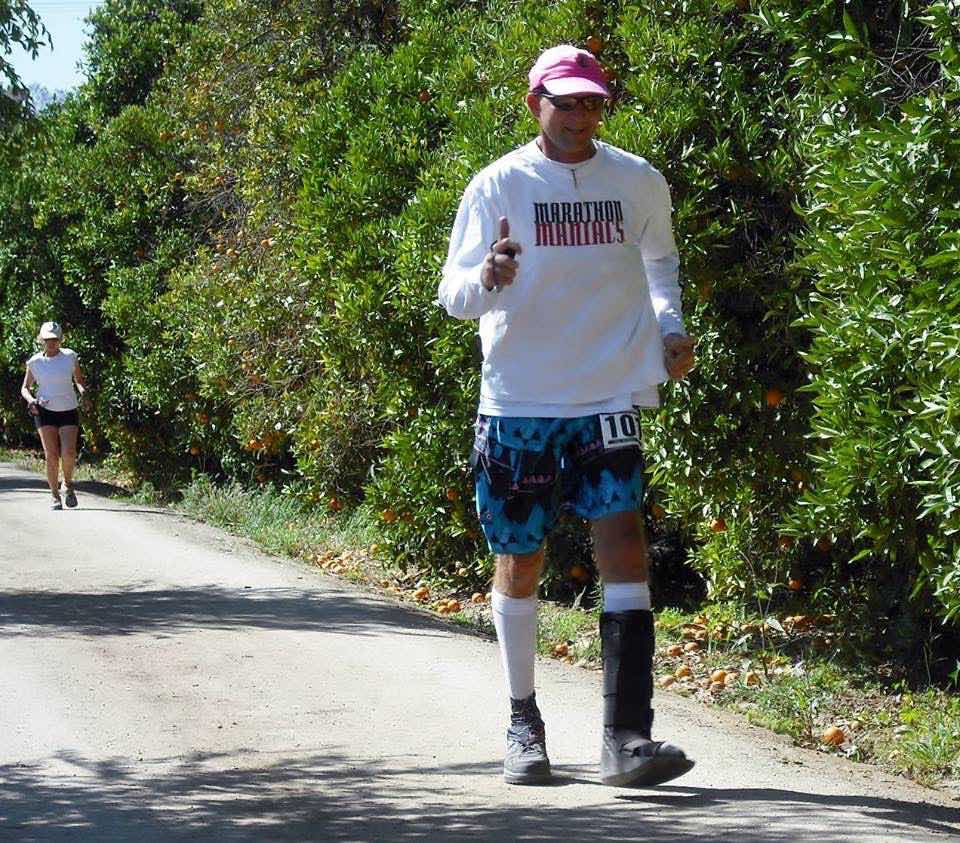
Ed in a walking boot during his second 100-mile race. Photo: Steve Harvey, directors of the Nanny Goat 24-Hour Race
Watching her finish and set the record, he got the competitive bug to try it himself. He began right away, in 2013, but quit in March due to an injury. When the 2014 new year came back around, he once again set out for the record and once again was nursing an injury. Ed nevertheless set aside the crutches he was using and took off, still determined to finish the race. He walked the whole thing, walked the next 100 miler he was signed up for, and in late January he was healed and on a roll. By April, there were 13 weekends in a row of 100-mile races. By December 31st, there were only a few Ed-venture situations, only one DNF, and a new record set with 41 races.
How does one plan and actually run forty-one 100-mile races in a year? My first thoughts were, How do you recover from each one and how can you afford that?
For Ed, there were a couple of factors that came into play for his incredible feat. First and foremost, there was unwavering support from his wife.
“My wife’s birthday is July 20th and our anniversary is July 17th… Guess what time of year Badwater is? The end of July. In 2010, I crewed Badwater and, in 2011, I ran the race and all seven years since then. So almost every single year on our anniversary and her birthday, she is out in Death Valley in a van full of stinky, sweaty men and that’s her anniversary. That shows what kind of wife she is.”
Martha herself said she was never officially approached by Ed about his interest in breaking records for the most number of marathons and 100 milers in a year, and though she wasn’t too keen on weekends spent at a race, she was happy to support him.
“I didn’t have a problem with him running–I’m all for balance, run a little, play a little. But alas, I knew who I married 35 years ago,” she said. “Ed has always been an all-or-nothing guy. He is a dreamer, looking at life–and people by the way–through rosy glasses. He usually chooses to see things from the positive side. By seeing the positive impact he had on other runners, I was encouraged to support him.”
She is also lenient with the cost; however, Ed aimed to get through the year as bare boned as possible. He kept traveling costs low by entering only in races located in the U.S. Southwest. During the marathon year, Ed was sponsored by Skechers shoes, in which the company paid for his marathon entry fees. The relationship did not last unfortunately when he attempted his 100-mile record, but a good friend, Ken Rubeli, who owns Beyond Limits Running, helped by paying about half of the entry costs.
“Without his help, I couldn’t have done it,” he added. Ed also had help from race directors after he told them what he was trying to accomplish. Some granted a free entry, some offered large discounts, and some made ‘deals’ with him. It was during one of these ‘deal’ races where Ed had his only DNF of the year. For an entry, Ed offered to run the race and sweep the entire course. During the Kodiak 100 Ultramarathon, Ed stayed in the back, running with the last runner. When that person jumped ahead, or despite Ed’s encouragement, dropped from the race, Ed would just run with another person. Near the 100k point, he was running with two runners who were struggling with the cutoffs and at the aid station were pulled from the race. Though he could have played the sweep card and kept going, he did not want to unfairly go on when his two companions could not.
Ed often finds and sticks with other runners throughout the race, thus constantly making new friends in the process. After the race, those runners often find Martha, telling her how much Ed made them laugh and helped out during those long miles.
Martha said, “By seeing the positive impact he had on other runners, I was encouraged to support him. The private messages he received, comments I would hear on the courses from others, how he encouraged them, supported them, inspired them, they made me realize it wasn’t just all about Ed and what he could do. It was about his passion, and sharing the love of running with others.”
Planning for races was done ‘Ed’ style, meaning he went by the seat of his pants, he said. Not wanting to pay in advance for races where something may come up, Ed signed up for races as the weeks went by, doubling up when he could and taking off weekends when he couldn’t find anything.
“I go by feel,” he said. “I usually had an idea of what races were coming up in the future and which ones I could do this weekend. Sometimes I could get two in one weekend. I would start on Friday, finish that up on Saturday, and then start another and end on Sunday.”
During the year of forty-one 100 milers, Ed rarely ran during the week, making each race both his racing and training. Having already finished two to three marathons in one weekend before, going into the year of 100 milers, Ed had some idea of what his body was capable of. For recovery and movement, he would, and continues now, to keep Monday as a powerwalk-only type of workout. He also gratefully asks Martha, who is a licensed massage therapist, to look at any nagging pains, and makes sure to continue living a healthy life.
“The body is amazing,” he said. “It is the only machine that the harder you work, the stronger it gets, as long as you don’t break anything.”
His weakness in any race is high altitude, he said. He suffers from terrible altitude sickness, so when he runs the Silverton 1,000 Multi-Day Run, he usually is forced to drop a few thousand feet to recover for one night.
To improve, he’s been working on both physical and mental training for altitude, since a few years ago it was more of a mental issue that caused Ed to DNF.
Throughout all of Ed’s 100 milers, there are eight DNFs, of which four are drop-down races, from a 100 miles to a 100k, for example. The Leadville Trail 100 Mile in 2013 was not one of those cases, sadly.
For Ed, those drop-down races are still DNFs. When he times out of a race, he walks away content since he knows he gave it everything he had. Yet in Leadville, when Ed was just past the turnaround part and heading back up the mountain, he talked himself right out of the race.
“I convinced myself that I sucked at elevation. That is my biggest regret, it still haunts me to this day,” he said.
Opposite of Leadville, Badwater is where Ed truly comes alive. The 135-mile road race was made for him, he said. “I’m a road runner, it doesn’t beat me up being on roads, and I do really well in the heat.”
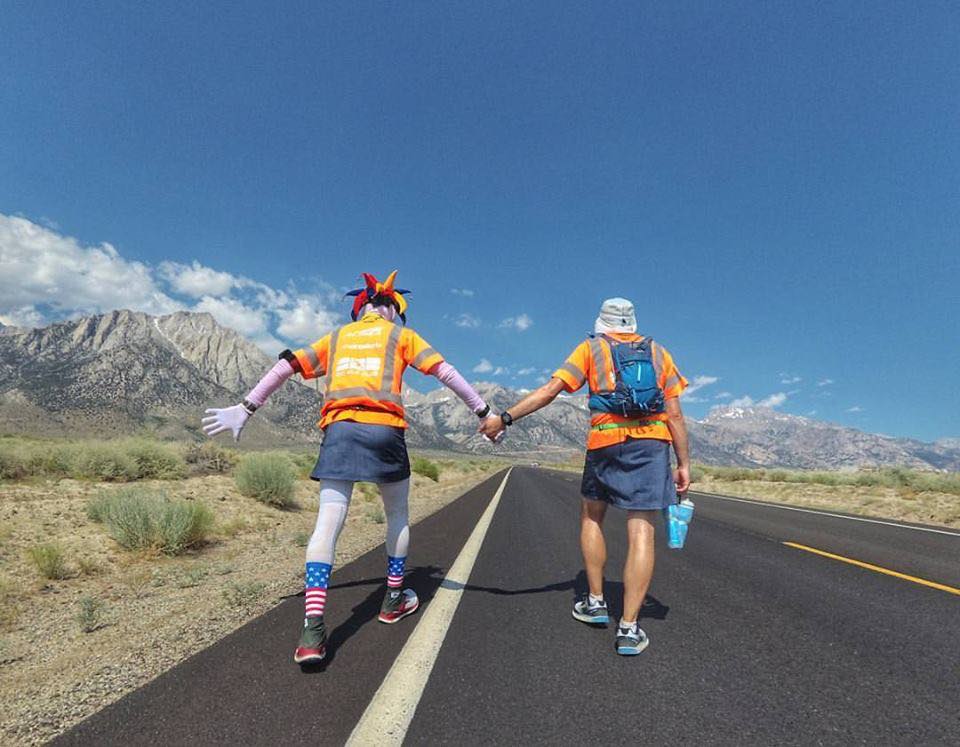
Ed and pacer Cory Reese ‘bromancing’ for the cameras on the climb to Whitney Portal during the 2017 Badwater. Photo: Patrick Sweeney
His first Badwater was in 2010 when he crewed for a man he had met in a previous ultra. Ed emailed him out of the blue, asking him if he could be part of the crew, and over the next 135 miles Ed fell in love with the race.
“I had never seen anything like it,” he said. “There were people from all over the world, the team effort, the beauty of the desert… I was in a whole new world. It was exciting and overwhelming.”
Ever since, Ed can be found running through Death Valley in July and this year will be his eighth trek in the desert.
“It means so much to me. If anyone asks me what my favorite race is there is no doubt about it, hands down. I know there are a lot of races, but for me it has such special meaning and memories.”
Martha too will be back in Death Valley as Ed’s crew chief.
“I remember staring out at the desert in Death Valley, watching the heat rays slowly wave above the sand, hot wind blowing in my face like a blowdryer, and wondering, What the hell am I doing here? I think I am literally in hell, swearing I will never come back,” she recalled. “But yet, each year I am compelled like a moth to the flame, to crew Ed at Badwater once again.”
Looking back on the year when the crew van’s battery died, staying in dive hotels, watching the stars come out each night, she says, “I wouldn’t miss it for the world.”

Team Jester for his second Badwater in 2012: Martha Ettinghausen, Steve Hernandez, John Wog, Colby Wentlandt, Brady Wentlandt, Ryan Launder, Shawna Wentlandt, and The Jester.
This year, his middle daughter Andrea will be with The Jester team as a pacer. Andrea has crewed in the past, and in 2020 she and Ed hope to be the first father-daughter racing duo.
Andrea is just beginning to take her first steps into the ultra world with the Nanny Goat ultra in May. She is of course being coached by Ed, and then plans on building up to the 2020 Badwater.
“Since I have had the honor of being on my dad’s crew for Badwater for so many years now, I can’t imagine how it would feel to actually be running as a participant alongside him, what an even bigger honor!” she said, laughing. “I’ll probably still be trying to spray him down and switch out his drink bottles, out of habit!”
Watching her dad finish race after race and accomplish amazing goals, Andrea said he inspires her every day to keep running in her life. Yet it was the day the two of them finished the Los Angeles Marathon together that first kickstarted the runner inside of her.
“One of my most cherished childhood memories with my father is crossing that first marathon finish line holding his hand,” she said. The two ran and walked the marathon in 2000, and again ran togther in 2010. “Having that memory fuels me when I’m going through tough times, remembering what one can accomplish if they put their mind to it. I can’t wait for 2020 to prove to myself what I am truly made of and how incredibly special it will be to have my father at my side knowing he helped build that fire inside me.”
Ed and Martha are also waiting to hear if Ed has earned an entry to Greece for the Spartathalon, which would also serve as the Ettinghausens’ first time out of the country.
For the past few years, Ed’s training consists of runs several days a week on his own, cross training, and he continues to average 25 to thirty 100 milers a year. In addition to speed training prescribed by his coach, Ed runs with children from the local school system. He has helped start a branch of the 100 Mile Club at the local school, where kids are motivated to run 100 miles a year. Ed helps the kids make their goal and everyone is awarded and celebrated at the end-of-year party, whether a child has run 100 miles or one.
“This program is in over 4,000 schools in the U.S. and Canada,” he said. “It is a very cool program. It makes the kids feel worthy and it is fun.”
A race called Run4Kids 25-Hour Running Party will take place this March to celebrate and raise awareness for the school program. Ed will be running, followed by the Beyond Limits Ultra 72-Hour Race in April and the Hotfoot Hamster 24-Hour Race and Nanny Goat 24-Hour Race in May.
With his record still standing three years later, Ed has changed his training to shoot for records that require a bit more speed. In 2015, Ed won seven races, in 2016, he won eight, in 2017, he won nine, and so in 2018, he hopes to win 10 races. He has already won one, the Celtic Winter Classic 24-Hour Run in late January.
“If I can win 10 that would be really cool,” he said. “These races are not Hardrock, but still I’m winning.”
While the birth certificate claims Ed’s age at 55, he simply doesn’t believe it. In fact, his body doesn’t feel 55 and his mind doesn’t act like 55.
“I still act like a kid,” he said, laughing.
If you see Ed running down the trail, jester hat flopping and skirt sashaying around him, his kid-like approach to running through life is pretty fun and contagious.
His entire year of 100-mile racing was pretty contagious as well, with people from all over the country checking in to see how he was doing. Friends and family were unbelievably supportive and threw together the tying and breaking–numbers 36 and 37–100-mile races just so Ed could celebrate his goal in town with everyone.
It was called the Jester’s World Record Run. A friend was disappointed to hear that Ed’s world-record-tying race would have to be out of state since there wasn’t anything close coming up. So, he organized a weekend of races, which included a 24-hour run and a 100-mile run. During the entire 24-hour race, Ed had friends and family crewing and running with him, and one friend he hadn’t seen in years even surprised him with a Starbucks Frappuccino around the 100k, his favorite treat.
His wife and kids finished the final loop with him, which was fun, he said, but he only had 10 minutes to sit down and regroup before getting to the starting line of the 100-mile race.
“I did the 24-hour race, so had no sleep, and then started the 100 which took me about 36 hours, so I was falling asleep while walking near the end,” he said, laughing.
With one person on one side of him and another on the other side keeping him from going off the side of the course, Ed finished with a mountain of applause and cheers.
“It made all the difference in the world having everyone there,” he said. “The experiences I have with my friends and family really motivate me.”
His family says the same thing.
“He’s crazy, of course.” Andrea added. “But the good kind of crazy. The crazy that accomplishes great things that people can admire and find inspiration in. He’s the kind of person who has such a strong drive, such strong will, he would never give up on anything he set his mind to.”
After the 37th race, Ed finished four more, ending the year with forty-one 100-mile races and could have done a lot more.
Talking to him, Ed can tell you off the top of his head how many 100 milers he’s completed, started, won, and which ones were sub-30 and sub-24 hours. He has thirty-eight 100-mile wins overall and believes that he could–with Martha’s blessing of course–run and finish sixty 100 milers in one year.
After finishing the first 100 miler in 2014, Ed never thought, Okay, one down, 35 more to hit the record. He just thought about the next race. He wasn’t out there to win, just run his best to get to the next race healthy and happy.
Ed looks forward to every race, whether it is a local 5k or 100-plus-mile race. He is excited every day leading up to the race, despite having just finished one the week before and the week before that. Every race is another opportunity to challenge himself, meet new friends, and share in memories and dreams.
If there is one thing Ed The Jester can teach people, it is how to have the type of crazy that turns dreamers into doers. Andrea is proof, she said. So is the three-year-old record for finishing the most 100-mile races in one year.
Maybe we could all benefit from a little bit of Jester crazy.
Call for Comments (from Meghan)
Do you know Ed ‘The Jester’ Ettinghausen? Have you run or been at the same race as him? Leave a comment to share a story!
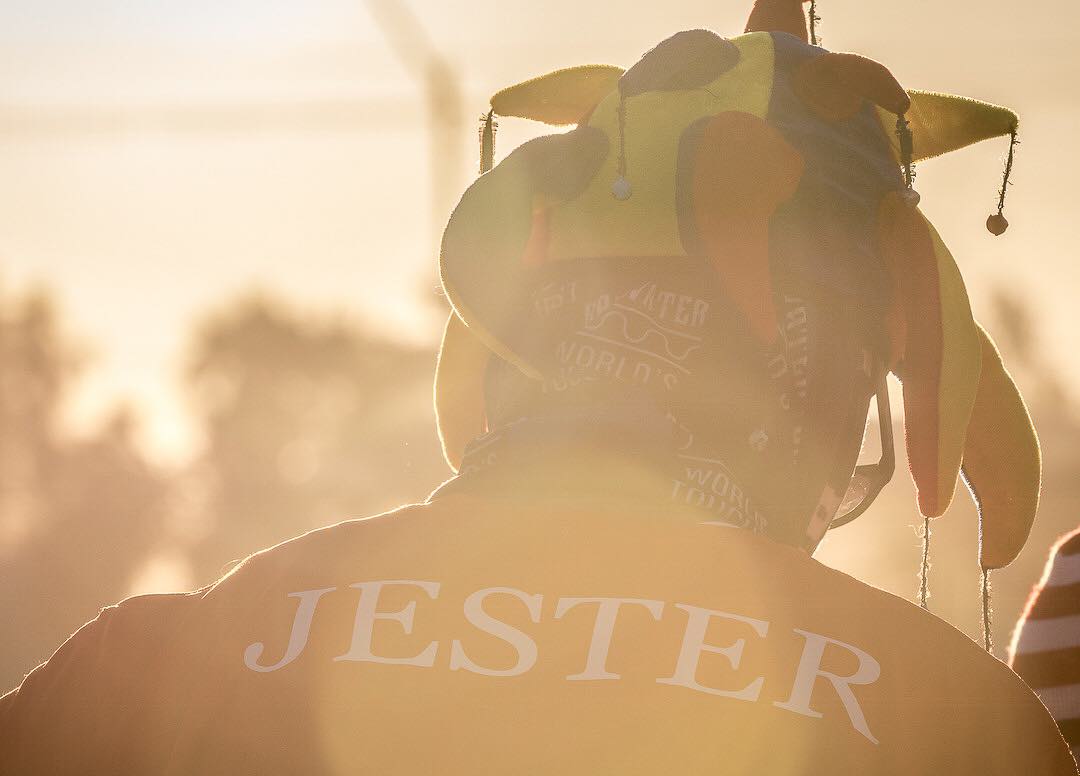
The Jester at the Desert Solstice. Photo: Jubilee Paige

